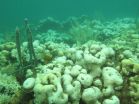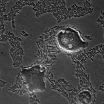(Press-News.org) TALLAHASSEE, Fla. -- A new study by a Florida State University biologist shows that bleaching events brought on by rising sea temperatures are having a detrimental long-term impact on coral.
Professor Don Levitan, chair of the Department of Biological Science, writes in the latest issue of Marine Ecology Progress Series that bleaching -- a process where high water temperatures or UV light stresses the coral to the point where it loses its symbiotic algal partner that provides the coral with color -- is also affecting the long-term fertility of the coral.
"Even corals that didn't bleach aren't reproducing at the levels they should," Levitan said.
Most corals reproduce by releasing sperm and eggs into the ocean during brief annual spawning events. The chance of sperm finding and fertilizing an egg depends on corals spawning in close proximity and in synchrony with each other.
In a study of the corals that build the major framework of Caribbean coral reefs, Levitan's team found that the species living in shallower water experienced near total reproductive failure, while the species living in deeper water was about half as likely to spawn.
"The remarkable finding from this study was that the reduction in spawning persisted for three additional years, long after the corals had regained their symbiotic partners and regained their normal appearance," Levitan said.
The worldwide decrease in coral abundance in combination with long-term reductions in spawning and reproduction following bleaching events put reef- building corals in a difficult situation. Eggs might be released, but never fertilized.
And that could have a major impact on the ecosystem at large.
Levitan's team has been studying coral that is just off the coast of Panama since 1996. And since then, those corals have been exposed to two bleaching events. On average, it takes coral three to four years to recover from bleaching.
"Even if we can fix what's killing these corals, it's going to be hard for coral populations to recover, because the surviving corals might not successfully produce enough offspring to repopulate reefs," he said.
The coral in that region is critical to building reefs, a crucial part of local ecosystems.
"There's a variety of reasons why people should care about this," Levitan said.
Coral reefs provide protection and shelter for many different species of fish. Without the reefs, certain fish are left homeless and without an area to reproduce. They also protect coastlines from large waves and flooding, a major issue in areas that are prone to tropical storms or hurricanes.
In the future, Levitan said his team would like to examine the quality of gamete production and also determine if corals that have already bleached are more or less likely to bleach again.
INFORMATION:
Levitan's graduate student William Boudreau, as well as Javier Jara from the Smithsonian Tropical Research Institute in Panama, and Nancy Knowlton from the Smithsonian National Museum of Natural History, were co-authors on the paper.
CONTACT: Kathleen Haughney, University Communications
(850) 644-1489; khaughney@fsu.edu
New research has found that one of the world's most prolific bacteria manages to afflict humans, animals and even plants by way of a mechanism not before seen in any infectious microorganism -- a sense of touch. This unique ability helps make the bacteria Pseudomonas aeruginosa ubiquitous, but it also might leave these antibiotic-resistant organisms vulnerable to a new form of treatment.
Pseudomonas is the first pathogen found to initiate infection after merely attaching to the surface of a host, Princeton University and Dartmouth College researchers report in the journal ...
A social sensing game created at Illinois allows researchers to study natural interactions between children, collect large amounts of data about those interactions and test theories about youth aggression and victimization.
The game's behavior analyses effectively identify classroom bullies, even revealing peer aggression that goes undetected by traditional research methods, the researchers say.
The game's developers say it is an improvement over traditional research methods, such as questionnaires, which do not assess interactions between youth in real time.
"What ...
When the mouse and human genomes were catalogued more than 10 years ago, an international team of researchers set out to understand and compare the "mission control centers" found throughout the large stretches of DNA flanking the genes. Their long-awaited report, published Nov. 19 in the journal Nature suggests why studies in mice cannot always be reproduced in humans. Importantly, the scientists say, their work also sheds light on the function of DNA's regulatory regions, which are often to blame for common chronic human diseases.
"Most of the differences between mice ...
Microbiologists at NYU Langone Medical Center say they have what may be the first strong evidence that the natural presence of viruses in the gut -- or what they call the 'virome' -- plays a health-maintenance and infection-fighting role similar to that of the intestinal bacteria that dwell there and make up the "microbiome."
In a series of experiments in mice that took two years to complete, the NYU Langone team found that infection with the common murine norovirus, or MNV, helped mice repair intestinal tissue damaged by inflammation and helped restore the gut's immune ...
For years, scientists have considered the laboratory mouse one of the best models for researching disease in humans because of the genetic similarity between the two mammals. Now, researchers at the Stanford University School of Medicine have found that the basic principles of how genes are controlled are similar in the two species, validating the mouse's utility in clinical research.
However, there are important differences in the details of gene regulation that distinguish us as a species.
"At the end of the day, a lot of the genes are identical between a mouse and ...
For more than a century, the laboratory mouse (Mus musculus) has stood in for humans in experiments ranging from deciphering disease and brain function to explaining social behaviors and the nature of obesity. The small rodent has proven to be an indispensable biological tool, the basis for decades of profound scientific discovery and medical progress.
But in new findings published online Nov. 19 in the journal Nature, researchers at the University of California, San Diego School of Medicine and Ludwig Cancer Research, with colleagues across the country and world, have ...
TALLAHASSEE, Fla. -- A new line of research from a team at Florida State University is pushing the limits on what the world knows about how human genetic material is replicated and what that means for people with diseases where the replication process is disrupted, such as cancer.
The team, lead by Department of Biological Sciences Professor David Gilbert and post-doctoral researcher Ben Pope, has taken an in-depth look at how DNA and the associated genetic material replicate and organize within a cell's nucleus. Their work could be especially crucial for doctors and ...
BOSTON - November 19, 2014 - Each year in the Northern Hemisphere, levels of atmospheric carbon dioxide (CO2) drop in the summer as plants inhale, and then climb again as they exhale and decompose after their growing season. Over the past 50 years, the size of this seasonal swing has increased by as much as half, for reasons that aren't fully understood. Now a team of researchers led by Boston University scientists has shown that agricultural production may generate up to a quarter of the increase in this seasonal carbon cycle, with corn playing a leading role.
"In the ...
ANN ARBOR--In a study that identifies a new, "direct fingerprint" of human activity on Earth, scientists have found that agricultural crops play a big role in seasonal swings of carbon dioxide in the atmosphere.
The new findings from Boston University, the University of Michigan and other institutions reveal a nuance in the carbon cycle that could help scientists understand and predict how Earth's vegetation will react as the globe warms.
Agriculture amplifies carbon dioxide fluctuations that happen every year. Plants suck up CO2 in the spring and summer as they blossom. ...
Physicists at the University of Groningen led by Professor of Functional Nanomaterials Beatriz Noheda have discovered a new manganese compound that is produced by tension in the crystal structure of terbium manganese oxide. The technique they used to create this new material could open the way to new nanoscale circuits. Their findings were published on 20 November 2014 in the journal Nature.
The researchers grew a very thin layer (no more than a few dozen atoms thick) of the terbium manganese oxide crystal on a thicker base layer of strontium titanium oxide. This base ...



